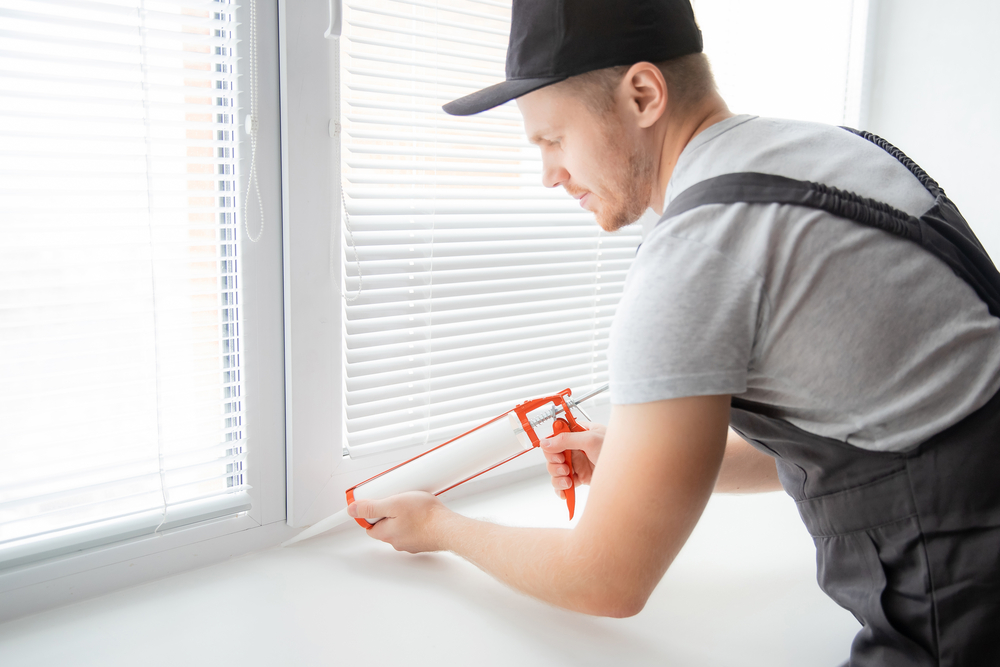Knowing how to caulk window trim is a fundamental property maintenance skill, crucial for aesthetic appeal and structural integrity. Caulking, an often-underestimated aspect of building care, is vital in protecting against weather and enhancing energy efficiency. Properly applied caulking around window trim prevents moisture infiltration and contributes to the overall insulation of a building. While seemingly straightforward, this process requires precision and understanding of the right materials, like Caulking & Sealants, to ensure a lasting and effective seal.
At Premier Building Restoration, we understand the importance of every detail in building maintenance, including expert window trim caulking. Our team of professionals uses only the highest quality Caulking & Sealants to ensure that your property is aesthetically pleasing, structurally sound, and weather-resistant. We specialize in providing top-notch caulking services that contribute significantly to the longevity and efficiency of your building, preserving its value and appeal in the competitive Philadelphia real estate market.
Tools and Materials Needed for Professional Caulking
Firstly, a high-quality caulk gun is essential. This tool should have a smooth pressure mechanism to ensure the even distribution of the caulk. The choice of caulk is equally important; for window trims, silicone-based caulk is often preferred due to its durability and flexibility, especially in varying Philadelphia weather. Acrylic latex caulk is also a good option, particularly for its paintable quality.
You will need a utility knife or a caulk remover tool to remove any old, peeling caulk from the window trim. This step is vital as the new caulk adheres best to a clean surface. A ladder might be necessary for safely reaching higher windows, emphasizing the importance of safety in such tasks. Other essential items include masking tape, which aids in achieving straight caulk lines and protecting surfaces from accidental smears. A damp cloth or sponge is handy for immediately cleaning up excess caulk, ensuring a clean finish.
A caulking tool or a small spatula helps smooth out the caulk bead, helping to blend it seamlessly with the window trim. Additionally, consider having a backer rod for larger gaps, which provides a base for the caulk, enhancing the effectiveness and durability of the seal.
Gloves are also recommended to protect your hands from direct contact with the caulk. With these tools and materials, property owners and historical preservationists in Philadelphia can ensure a neat and effective caulking job, enhancing the appearance and longevity of their window trims.
Preparing the Window Trim for Caulking
Start by thoroughly cleaning the area around the window trim. Remove any dirt, grime, old paint, or flaking caulk using a brush, cloth, or scraper. This process creates a clean and smooth surface for the new caulk to adhere properly.
If there’s an existing old or damaged caulk, carefully remove it with a utility knife or remover tool. Ensure that all remnants of the old caulk are removed, as the new caulk adheres best to a surface free of old materials. After removing the old caulk, clean the area again to remove any residual particles or dust. A vacuum cleaner can effectively remove fine debris from the crevices.
Before applying new caulk, you should repair or fill larger gaps or damaged areas. In such cases, use a backer rod or a suitable filler to even out the surface. Once the window trim is clean and any necessary repairs are made, apply masking tape along the edges of the trim. This tape will help create a straight line and protect the surrounding areas from excess caulk.
Dampen the area lightly before applying the new caulk. This step is crucial as it helps the caulk to adhere better and seal the joint effectively. Proper preparation of the window trim not only enhances the appearance of the caulking job but also extends its durability, an important consideration for maintaining properties in Philadelphia, where weather conditions can fluctuate and impact the building exteriors.
Techniques for Applying Caulk to Window Trim
Begin by ensuring the caulk gun is loaded properly with your chosen caulk. Cut the caulk tube’s tip at a 45-degree angle, making a small opening that matches the size of the gap you’re filling. For a clean and controlled application, hold the caulk gun at an angle parallel to the window trim, applying steady pressure to the trigger for a consistent flow. Start at one corner of the trim and smoothly drag the gun along the seam, maintaining an even pace to lay down a uniform bead of caulk.
Applying the caulk in one continuous line is important to avoid breaks and ensure a watertight seal. If the line of caulk breaks, gently overlap with the previous section to maintain continuity. It might be necessary to caulk in sections for larger windows, but always strive for a continuous application along each trim side.
As you apply the caulk, avoid overfilling the gap. Adding more caulk later, if needed, is easier than removing excess. Be mindful of the caulk emerging from the tube and adjust the pressure on the gun accordingly. This technique ensures that the caulk fills the gap entirely without overflowing, which is crucial for the seal’s effectiveness and final appearance.
For property owners and historical preservationists in Philadelphia, mastering these caulking techniques can make a significant difference in maintaining their windows’ integrity and aesthetic appeal. Properly applied caulk enhances energy efficiency by sealing drafts and contributes to the overall look of the property.
Smoothing and Finishing the Caulk for a Professional Look
Immediately after laying the bead of caulk, use a caulk smoothing tool or your finger, dipped in soapy water, to gently smooth the caulk into the gap. This step presses the caulk into the seam for a better seal and removes any excess, creating a clean, uniform line.
When smoothing the caulk, start at one end and move steadily to the other, maintaining consistent pressure. This helps to create a smooth, even surface that blends seamlessly with the window trim. If you’re using your finger, regularly clean it off in the soapy water to prevent buildup and ensure a smooth finish.
For a more professional appearance, you can use masking tape placed along the edges of the window trim before applying the caulk. Once you’ve smoothed the caulk, carefully remove the tape while the caulk is still wet. This technique leaves a crisp, straight line and prevents the caulk from spreading onto adjacent surfaces.
Once finished, it’s important to let the caulk dry and cure according to the manufacturer’s instructions. Avoid touching or painting over the caulk until it’s fully set. This patience ensures that the caulk has time to form a strong bond, resulting in a neat, clean appearance.
For property owners in Philadelphia, these finishing touches are crucial in preserving their buildings’ aesthetic and historical integrity. A well-executed caulking job not only protects the window trim from weather and moisture damage but also enhances the property’s overall look, contributing to its curb appeal and value.
Drying and Curing: Ensuring Long-lasting Results
Drying refers to the caulk losing its initial moisture and beginning to set, while curing is the process by which the caulk fully hardens and reaches its maximum durability. The time required for drying and curing can vary based on the type of caulk used, humidity levels, and temperature. Typically, most caulk takes 24 hours to dry to the touch, but it can take several days or weeks to cure fully.
During this period, protecting the freshly caulked areas from water, extreme temperatures, and direct sunlight is important. Excessive moisture or rapid temperature changes can cause the caulk to crack or shrink before it’s fully cured. In climates like Philadelphia, where weather can be unpredictable, checking the weather forecast before starting your caulking project is wise.
Avoid painting over new caulk until it is completely cured. Painting too early can interfere with the curing process and lead to poor adhesion or a weakened seal. The caulk’s packaging should provide specific instructions on cure times and conditions, which are essential to follow for optimal results.
Tips for Maintaining Caulked Window Trim
Regular maintenance ensures the longevity of the caulk and prevents potential issues like air leaks or water infiltration. Firstly, it’s important to conduct regular inspections of the caulked areas. Look for signs of wear and tear, such as cracking, peeling, or gaps in the caulk. These can develop due to exposure to weather, temperature fluctuations, or simply over time.
For cleaning, gently wash the caulked surfaces with mild soap and water. Avoid using harsh chemicals or abrasive scrubbers, as these can damage the caulk. A soft cloth or sponge is usually sufficient to remove dirt and grime. If you notice mildew or mold growth on the caulk, promptly address it with a suitable cleaner, ensuring it’s compatible with the caulk used.
Minor cracks or separations in the caulk can be repaired by applying a small amount of fresh caulk to the affected area. Make sure the area is clean and dry before reapplying. Removing the old caulk and re-caulking may be necessary for larger issues to ensure a proper seal.
Protecting the caulk from extreme weather is also important. In Philadelphia, where winters can be harsh, check the caulk before the cold season to ensure it’s intact and ready to withstand the winter conditions.
Common Mistakes to Avoid in Window Trim Caulking
One of the most frequent mistakes is failing to prepare the surface properly. This includes not removing old, peeling caulk or neglecting to clean the area thoroughly. New caulk adheres best to a clean, dry surface, so skimping on this step can lead to poor adhesion and longevity of the caulk.
Another mistake is using the wrong type of caulk. Only some caulks are suitable for some jobs; a weather-resistant caulk like silicone or acrylic latex is recommended for window trims. For instance, using interior caulk for an exterior job can result in the caulk failing due to weather exposure.
Applying too much or too little caulk is also a common error. Over-application can lead to messy, bulging lines that look unprofessional and affect the drying and curing process. Conversely, applying too little caulk might not provide adequate coverage to seal gaps effectively.
Cutting the caulk tube tip incorrectly can also lead to issues. The tip should be cut at a 45-degree angle to a size matching the gap being filled. This ensures a smooth and even application.
Furthermore, neglecting to smooth the caulk after application is a mistake that can leave the caulk line looking rough and unfinished. Smooth, well-blended caulk lines are essential for both aesthetics and function.
Advanced Techniques for Challenging Caulking Scenarios
When dealing with large gaps or irregular surfaces, using a backer rod before caulking can provide better control and a more uniform fill. The backer rod acts as a filler, reducing the caulk needed and helping maintain the proper depth-to-width ratio.
In cases where multiple materials meet, such as wood and masonry, using a caulk that can accommodate different expansion and contraction rates is crucial. A high-quality, flexible caulk is ideal for such scenarios to prevent cracking or splitting due to temperature changes.
Applying caulk with precision is key for areas with intricate detailing or decorative elements. Using a smaller caulk tip or even a fine-tipped applicator can provide the control needed for detailed work. This technique is particularly useful in historic buildings in Philadelphia, where preserving architectural details is essential.
When caulking in cold weather, it’s important to ensure that the caulk remains at a workable temperature. Storing the caulk tubes in a warm area before use can keep the material from becoming too stiff to apply smoothly. Additionally, warming the surface to be caulked, within reason, can improve adhesion.
In situations where aesthetics are as important as functionality, such as in visible areas of a property, color-matched caulk can blend seamlessly with the surrounding materials. For a perfect match, custom-colored caulk might be necessary.
These advanced techniques require skill and experience, making them more suited for professional caulking services. However, understanding these methods can benefit property owners and preservationists in Philadelphia, ensuring they are well-informed when tackling challenging caulking projects or hiring professionals for the job.
Seal the Deal with Premier Building Restoration
For property owners, historic preservationists, and businesses in Philadelphia, ensuring your building is properly maintained with the best Caulking & Sealants is crucial. Premier Building Restoration offers comprehensive services, including expert advice on how to caulk window trim and professional application. Trust us to enhance your property’s longevity and appearance with our superior caulking services. Contact us today for a consultation and take the first step in safeguarding your valuable investment with our exceptional restoration expertise.










